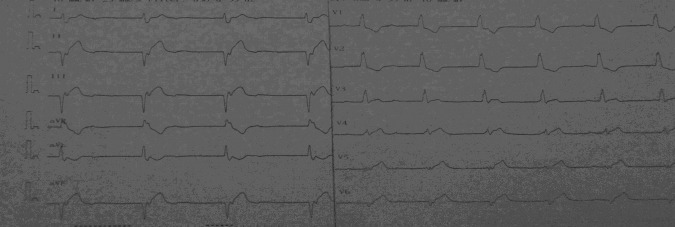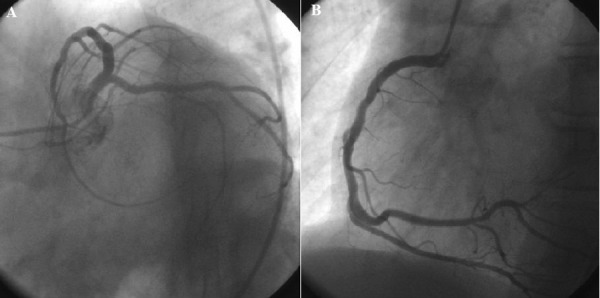Abstract
Coronary angiography remains as the gold standard for the diagnosis of coronary artery disease. Serious complication due to coronary angiography is very rare and generally it is considered safe in experienced hands. Here, we would like to present two cases without severe stenosis in the coronary arteries suffering from cardiac arrest soon after the procedures, and draw attention to this lethal complication and review the possible causes of sudden death occurring after coronary angiography.
Background
Coronary artery disease remains as the foremost cause of death in the world. Coronary angiography is regarded as the gold standard for the diagnosis of coronary artery disease. Serious complication due to coronary angiography is very rare and generally it is considered safe in experienced hands. Here, we would like to present two cases without severe stenosis in the coronary arteries suffering from cardiac arrest soon after the procedures. We want to draw attention to this lethal complication and review the possible causes of sudden death occurring after coronary angiography.
Case presentation
Case report 1
A 31-year-old woman was brought to the emergency room with a sudden deterioration of the general condition. Electrocardiography was in sinus rhythm and inferolateral derivations revealed ST segment elevation (figure 1). Soon after transfer to the coronary intensive care unit cardiac arrest was observed and cardiopulmonary resuscitation was performed; however, despite all efforts the patient was considered exitus. From her history collected from her relatives we learnt that 20 h before admission to our emergency room the patient underwent a coronary angiography elsewhere. Her coronary angiography revealed normal vessels and she had been discharged from the hospital (figure 2). Her history was unremarkable in terms of coronary risk factors.
Figure 1.

Electrocardiography of first patient shows sinus rhythm and inferolateral derivations revealed ST segment elevation.
Figure 2.

Coronary angiography of first patient revealed normal vessels. (A) Left coronary artery and (B) right coronary artery.
Case report 2
A 60-year-old woman was referred to our coronary angiography department with symptom of atypical chest pain and positive exercise treadmill test. Except for the history of well-controlled hypertension and mild obesity (body mass index: 28 kg/m²) other atherosclerosis risk factors were not present. Her angiography revealed non-critical plaque without severe stenosis (figure 3). Soon after removing the sand bag 4 h later from angiography the patient suffered from sudden dyspnoea. Her echocardiography revealed a right ventricle enlargement. During transfer of the patient for an urgent pulmonary angiography for possible diagnosis of her pulmonary embolism complications developed and the patient failed to respond to all resuscitative efforts and died.
Figure 3.

Coronary angiography of second patient revealed non-critical plaques (A) left coronary artery (B) right coronary artery.
Discussion
Here we would like to draw the reader's attention to the two deadly complications of coronary angiography: (1) a silent coronary dissection or aortic dissection due to catheter manipulation has possibly occurred in case 1; (2) a prolonged sand bag pressure on femoral artery access site may cause deep vein thrombus to migrate and result in pulmonary embolism after the sand bag is removed.
It has been reported that death after coronary angiography is rare (0.02%).1 Left main coronary artery lesion, advanced age, multivessel disease, heart failure, aortic stenosis and renal failure are reported as the risk factors causing sudden death after coronary angiography.2 3
After diagnostic coronary angiography aorta-coronary dissection, which is observed more frequently in the right coronary artery, might result in a fatal outcome, thus diagnosis and urgent treatment is life saving. Left main coronary artery lesion dissections related death rate is reported as 3%, and also require suspicion and urgent treatment. The risk of sudden death is higher in patients with heart failure and low ejection fraction.2 3
Cerebrovascular disease is also rarely reported after coronary angiography and risk factors for its complication are as follows: catheter microtrauma and microembolisation due to cholesterol embolies, long time of the process and aggressive anticoagulation particularly in percutaneous coronary interventions. The risk of stroke is reported as 0.44%.4 Pulmonary embolism is seen to be rarely associated with a high death rate (50%) in the first 24 h after coronary angiography.5
During or after the procedure, removal of the arterial canula may cause vagal reaction, severe bradycardia and hypotension. Close haemodynamic follow-up is vital.
Taken together, the two presented cases underscore the importance of the following learning points: first, after coronary angiography any development of chest pain should be seriously considered for possible development of aortic or coronary dissection even in the condition of completely normal vessels. Second, a prolonged sand bag compression on the femoral site should be avoided as much as possible. Especially in elderly and obese patients sand bag compression on the femoral site and immobilisation should be kept for shortest duration.
In summary, although rarely seen, coronary angiography holds the risk of sudden death. Unnecessary procedure should be avoided as much as possible.
Learning points.
Coronary angiography might lead to coronary or aortic dissection even in the condition of entirely normal coronary vessels.
Chest pain after normal coronary angiography should alarm the physician about the possible vessels dissection. Thus the dissection of both aorta and coronary vessels can be ruled out.
Prolonged sand bag compression on femoral artery should be avoided especially in elderly and obese patients in terms of potential for pulmonary embolism.
After prolonged sand bag compression, occurrence of dyspnoea should warrant the physician about pulmonary embolism complication.
Footnotes
Competing interests: None.
Patient consent: Obtained.
Provenance and peer review: Not commissioned; externally peer reviewed.
References
- 1.Yu MY, Gao RL, Chen JL, et al. [Complications in selective coronary angiography: analysis of 9196 cases]. Zhonghua Yi Xue Za Zhi 2003;83:91–5 [PubMed] [Google Scholar]
- 2.Tavakol M, Ashraf S, Brener SJ, et al. Risks and complications of coronary angiography; a comprehensive review. Global J Health Sci 2012;4:65–93 [DOI] [PMC free article] [PubMed] [Google Scholar]
- 3.Anderson HV, Shaw RE, Brindis RG, et al. Risk-adjusted mortality analysis of percutaneous coronary interventions by American College of Cardiology/American Heart Association guidelines recommendations. Am J Cardiol 2007;99:189–96 [DOI] [PubMed] [Google Scholar]
- 4.Dukkipati S, O'Neill WW, Harjai KJ, et al. Characteristics of cerebrovascular accidents after percutaneous coronary interventions. J Am Coll Cardiol 2004;43:1161–7 [DOI] [PubMed] [Google Scholar]
- 5.Chen X, Chen YD, Lü SZ, et al. [Outcome of fatal pulmonary embolism post coronary intervention]. Zhonghua Xin Xue Guan Bing Za Zhi 2006;34:822–4 [PubMed] [Google Scholar]


